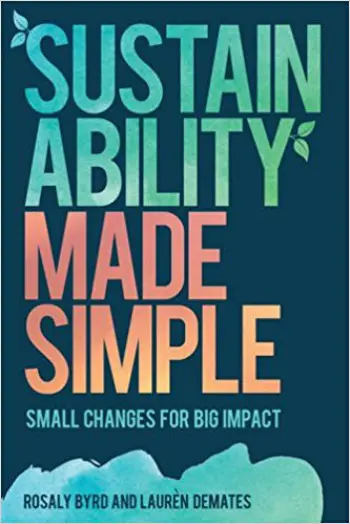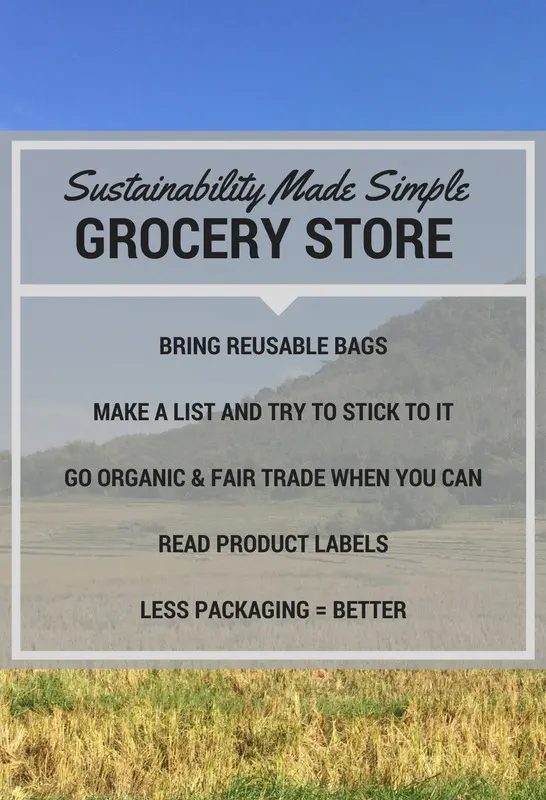Sustainable shopping is more than just a trend—it’s a conscious choice to support a healthier planet and a more ethical economy. By choosing eco-friendly products, reducing waste, and supporting brands that prioritize fair labor and environmental responsibility, consumers can make a meaningful impact with every purchase. Whether you’re buying clothing, groceries, or household goods, sustainable shopping encourages mindful consumption that benefits both people and the planet. With that in mind, I have some tips from the experts on how to shop sustainably.
You may be wondering what you can do to shop more sustainably. Well, Rosaly Bird and Lauren DeMates are co-authors and founders of The Sustainability Co-Op blog, which strives to understand and communicate the interconnectedness between global and local societal needs and environmental concerns. They have recently published a book on the subject of of sustainable living called, Sustainability Made Simple: Small Changes for Big Impact. I love how this books focuses on making it simple to integrate environmental considerations into daily life. I am so pleased to be able to share with you today, through agreement with the book publisher, an excerpt that will help you make an impact by shopping sustainably.
From Sustainability Made Simple: Small Changes for a Big Impact, by Rosaly Bird and Lauren DeMates. Copyright © 2017 Rowman & Littlefield. Used by arrangement with the publisher. All rights reserved. No part of this excerpt may be reproduced or printed without permission in writing from the publisher. The book is available from your local book sellers. I have included my affiliate amazon link for your convenience.
Sustainable Shopping Tips
The environmental footprint of the food and material goods we consume is often difficult to observe due to global complex supply chains. Although it’s easy to feel disconnected from the deforestation, air and water pollution, and greenhouse gas (GHG) emissions often associated with our products, we as consumers have the ability to decrease this negative impact. We can reward companies that are doing things more sustainably, such as using natural resources more responsibly, reducing their GHG emissions, and paying workers a living wage, by choosing their products over companies that are not committing to taking on these issues. Thinking about the impact of your purchases is the main way to be sustainable at the store, but picking up other small habits can also directly minimize our environmental footprint and improve our lives.
PLAN AHEAD
Bring reusable bags.
Using reusable bags (cloth, paper, or plastic), or hand-carrying items if you are only picking up a few things, cuts down on waste. Many cities have banned plastic bags altogether, and some stores now charge for new bags that just a few years ago were free. Even if your city hasn’t made the move on plastic bags yet, you can take matters into your own hands by remembering your reusable bags.
Make a list and try to stick to it.
Around 20 percent of the food we buy never gets eaten. Meal planning can help make sure you aren’t buying extra food that will go bad before you have time to eat it. This is not only applicable at the grocery store, but can be applied when visiting any other store as well. Thinking about and rationalizing your planned purchases before you go to the store can help you avoid unnecessary things, (or impulse-buys), which take energy, water, and other resources to produce.
PRODUCT PACKAGING
Go for the bulk bins.
Grocery store bulk bins offer commonly used items such as nuts, grains, spices, granola, and cooking basics without all the packaging. Plastic bags are usually available, but you can avoid those by bringing your own reusable containers or bags to fill up.
A handful of “package-free” stores have popped up in cities from Berlin to Austin in the last few years, which carry a wide range of local products such as produce, nuts, grains, and eggs – all in bulk. Although package-free stores are far from being accessible to most people, it’s exciting to see and know what’s possible.
Look for products that minimize packaging or ones that you can reuse.
Of course, no packaging is the ideal option, but for a lot of items we consume, this unfortunately is not a choice. When deciding between comparable products, choose the one that uses less packaging, or recyclable packaging that you can reuse at home, like glass jars and containers.
BUYING FOOD- How To Grocery Shop Sustainably
Read product labels.
Certification labels (e.g., Organic, Fair Trade) are helpful in identifying products that meet a specific standard of environmental impact. Choosing these products is a great way to purchase sustainably, but it is still worthwhile to take the time to read product labels and packaging to help you make even more informed decisions. The certification label system was invented in part because product labels and packaging are sometimes confusing and not so forthcoming with the information you may be looking for. However, the absence of a certification label doesn’t automatically mean it’s an unsustainable product, and this is when diving into the details of the product label can be useful. Also, when studying up on a specific product, be conscious of greenwashing, which is information disseminated by a company about their product that makes it appear more environmentally friendly than it actually is.
Beware of ingredients that may come from unsustainable sources.
Some of the ingredients in foods may come from unsustainable sources, and because of the complicated and nontransparent nature of supply chains, it is often difficult to determine which ones are harmful and which ones are not. For instance, some of the ingredients you may find in your food are associated with deforestation, including palm oil, cocoa, and soybeans. It’s hard to completely avoid these ingredients as palm oil in particular is used in about 50 percent of all packaged food products in supermarkets today and can also be found in your personal care products.
However, you can keep an eye out for companies or products that have reputable certifications like Rainforest Alliance certified or Roundtable on Sustainable Palm Oil (RSPO) certified, which lets you know they source responsibly. You can also check to see if your preferred food brand signed onto a zero-deforestation policy, and how they are faring in achieving this goal with Greenpeace’s Company- Scorecard guide.
BUYING CLOTHES- How To Shop Sustainable Fashion

Decide whether you really need it.
It’s common to see clothes on sale or at a good price and be tempted to buy them, even if you don’t need them. But in thinking about the environmental costs associated with producing that shirt or pair of pants, it is likely that this low price does not reflect the price of the natural resources that were exploited to make it. Some of the environmental impacts associated with the textile industry include the use of large amounts of water, pesticides for cotton farming, toxic dyes and cleaning chemicals that pollute waterways, the generation of a lot of waste, and extraction of natural resources: all impacts that have negative effects on ecosystem services.
Support sustainable cotton.
Growing cotton is energy and water-intensive; according to the World Wildlife Fund, it can take 2,700 liters to produce enough cotton for a single t-shirt. To put that into perspective, that same amount of water could supply one person with drinking water for 900 days. In addition, cotton is considered one of the dirtiest crops due to its reliance on insecticides and other chemicals that decrease biodiversity and contaminate local water sources.
Organic cotton is currently the most sustainable cotton available because it doesn’t rely on insecticides, so soil nutrients and biodiversity are preserved, and it allows the soil to retain more water, thus needing less irrigated water. By choosing sustainable clothing made with organic cotton, you’re signaling that you value efforts to make the production of clothes and textiles more responsible. Also, look for brands that support The Better Cotton Initiative, which seeks to improve the social and environmental issues associated with cotton. Alternatives to cotton are slowly gaining traction and include hemp, tencel, bamboo, and even recycled plastic bottles.
Hemp And Bamboo Clothing.
Hemp is one of the most useful and environmentally friendly materials found. Cloth made from hemp uses considerably less water than cotton and is resistant to pest thus it does not herbicides. Hemp is classified as an Eco textile meaning it requires less energy, produces less carbon and, therefore, creates less pollution than other forms of fabric manufacturing. Bamboo has recently been gaining popularity as a sustainable fabric as it does not require pesticides, regrows quickly after a cutting, and absorbs 35% more carbon dioxide than an equivalent stand of trees.
How To Shop Sustainably Conclusion
I hope you enjoyed the authors’ helpful tips on how to shop sustainably. Their book is packed with helpful tips for things like how to make meal choices that are good for you AND the environment. They also share how to throw a party or host a holiday dinner that is a terrific celebration AND planet-friendly. You will even find simple tips for making your kitchen a more sustainable-friendly area of your home, and more. You can also follow the authors on Instagram: @sustainability_cooperative.
Thank your for being interested in sustainable products and sustainable brands. It is a great way to vote with your wallet and lower your carbon footprint. It just so happens that it is also a great way to support local small businesses. Making choices that support a sustainable future feels good! Purchasing from ethical brands that have high-quality products that last and natural fibers with a lower impact ensure a brighter outcome for future generations. Try making one simple improvement at a time like using cotton bags and doing more second-hand shopping. Which of these sustainable shopping tips will you implement first?
Related Posts:



Marlee says
Great post! I really appreciate how you highlighted the importance of making a conscious effort when it comes to shopping. Choosing sustainable clothes made from organic materials and supporting t-shirt brands with ethical supply chains is such a powerful way to help create a better planet. It’s also great to look for third-party certification to ensure we’re making the most sustainable choice and supporting local communities at the same time.
Simranjeet Singh says
Such an inspiring read! It’s amazing how our shopping decisions can support sustainable practices and even promote animal health and the use of renewable energy. I love the idea of choosing a local store that aligns with these values—it really shows how small changes can make a big, positive impact.
Wilma says
I found this information on sustainable shopping really helpful, especially the tips on using recycled materials to reduce environmental impact. Embracing a zero waste mindset takes some planning, but it’s so worth it for the planet.
outerwear trends says
Loved these expert tips! Sustainable shopping can feel overwhelming at first, but small changes like choosing quality over quantity and supporting ethical brands really do make a difference. Thanks for breaking it down so clearly!
v vidya says
This excerpt offers practical and empowering advice for making sustainable choices—it’s a great reminder that even small habits, like bringing reusable bags, can lead to meaningful change. The authors make sustainability feel approachable and impactful for everyday shoppers.